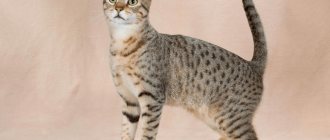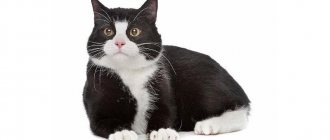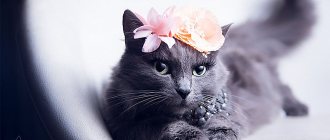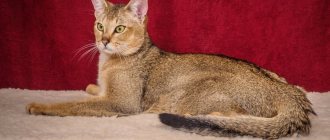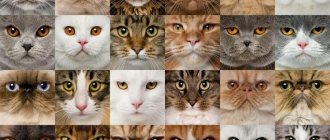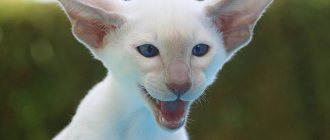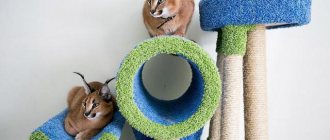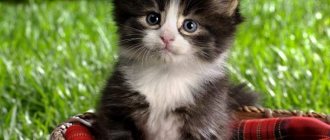Cats usually give the impression of being affectionate and friendly animals. However, some of them are quite aggressive and can cause serious injury. Therefore, in order not to fall into the unpleasant statistics of pets injured by claws, before buying a tiny, cute kitten, it is worth finding out more about the character of the chosen breed. And information about which of the existing varieties of cats are considered the most dangerous in the world will help with this.
The most dangerous cats in the world: characteristics
The love for exotic, rare pets, the desire to impress guests with an unusual animal living in the house has led to people getting cats that are completely unsuitable for apartment keeping.
The action leads to inconvenience. Wild animals spoil the design of housing, avoid people, get sick, experience chronic stress, and some representatives are quite dangerous for the owner and his family.
Mekong Bobtail
The Mekong Bobtail is the safest cat breed compared to all of the above. The height of a cat of this species reaches 30 centimeters at the withers, and it weighs no more than 4 kilograms.
If you train such a pet, it will be docile and calm. However, the Mekong Bobtail only gets used to one person. As a rule, he listens only to his master. The pet is wary of strangers. If he doesn't like something, he can easily attack a stranger.
The main danger of these 5 breeds is that they all come from wild cats. Consequently, raising such pets is extremely difficult. Only those who are willing to train and care for them should own such pets.
Savannah
Cats seem to have stepped out of ancient Egyptian frescoes: graceful flexible body, long legs and neck, small head, pointed ears.
The thick, short, spotted coat makes the cat look like a miniature version of a leopard. Savannahs tend to show a sharp character, wild habits, and aggressiveness. They may perceive strangers and other animals as objects of hunting. They can only be walked on a leash.
Abyssinians
The breed is suitable for people who are not ready to constantly communicate with their pet and do not expect excessive affection from it. The Abyssinian will take care of herself very well, prefers solitude, does not like to be cuddled, forced to play, and hides on closets and other high places in the apartment.
She has a developed intellect, is capable of learning to walk on a leash, fetch, and other commands, but tends to be quick-tempered.
Playing with her is fraught with scratches and bites. Having been punished, she is offended and vindictive. She is inquisitive, active, and if she picks up the key to her prickly character, she gets a devoted friend.
Dangerous domestic cats
Usually cats are seen as cute creatures that create a certain comfort in the house. However, the fluffy face in the photo may turn out to be an aggressive cat in real life. Before welcoming a new member into the family, you should study those dangerous breeds of cats that are capable of showing cruelty towards humans.
Siamese cat
A vindictive representative of his family. The Siamese breed is famous for having one of the most vicious morals in the world, despite its delightful coloring and mesmerizing blue eyes. They can harbor a grudge against their offender for a long time and attack him at the most unexpected moment. The Siamese cat is very dangerous for small children, who, due to their lack of awareness, can offend him.
Best articles: How to determine the breed of cats and cats?
Maine Coon
The cat is a large breed with a wide chest and a massive body. His weight can reach 15 kg without obesity. Maine Coons are not safe for people. Due to their size, they are capable of crippling their owner or strangers. Cats are very smart and flexible, they do not like to be left alone. For the slightest human offense, a dangerous animal can take revenge, as they have a very changeable temperament.
shutterstock
British breed
The British are proud cats with a wayward character. Due to their independence, they do not like strangers and allow themselves to be petted very rarely. To achieve a friendly relationship with a cat, you will have to spend a lot of time on it and communicate with it often.
Abyssinians
A vengeful animal with thick fur. They do not like to sit on their owner's lap for a long time. Cats prefer to sit in high places where they are difficult to reach. Abyssinians are very vindictive, so it takes a lot of time to train them. You should mentally prepare yourself for scratches and bites, without which not a single game can be played.
Siberian cats
An independent disposition, a fluffy face and a large body - this is a Siberian breed. These cats can only make friends with a self-respecting person. In addition to aggression, the pet is able to show affection towards the owner. They get along well with other animals, but they react warily to strangers.
shutterstock
Bengal cats
The Bengal breed is a domestic cat with an impulsive character. He has a well-developed hunter's instinct. To avoid an aggressive disposition, Bengals should be raised with love and affection from childhood, and the kitten should be given a lot of attention. In moments of aggression, adults are capable of causing serious injuries to humans. Bengal cats are very active. They do not tolerate sitting on their hands or raised tones addressed to them.
Chausie
The Chausie is a predator that is very similar to the puma. His body is much more powerful than other domestic breeds. The cat is ready to hunt at any time. His aggressive behavior needs to be stopped from childhood. Spacious properties in private homes are better suited for keeping chausies. They enjoy heights and constant exercise.
Reed breed
Jungle cats are practically impossible to train. These are true predators. They are distinguished by their active and at the same time lazy character. If you managed to domesticate a cat, you will need to communicate with him a lot. Otherwise the animal will go wild again.
Manul
Almost the most aggressive cat is the Savannah. This slender cat with a small head has a beautiful leopard print color and pointed ears.
shutterstock
The cat is aggressive, but it can still be tamed. A domesticated savannah dog on a leash accompanies its owner. When walking, you should especially closely monitor the animal, since it can react to a stranger as if it were prey.
Savannah
The Pallas's cat is almost impossible to train. The kitten is gloomy and indomitable. He will not be affectionate, playful and homely. In the house the manul will be unsociable and uncontrollable. An untamed cat will very quickly create chaos and disorder in the house.
Cats are predators by nature. Most of them, even after many years of domestication, can show sudden aggression. Most often, the cause of anger is pain, struggle for the owner or territory, and fear.
https://youtube.com/watch?v=mjzW3—oBiE
Manul
A wild cat does not live well in captivity. Kittens taken into the home, even with constant contact with people, remain wild, strive for solitude, and hide in secluded places.
An adult animal looks brutal, resembling a lynx. It reaches a height of 65 cm, weight up to 5 kg, but due to its thick, long, lush fur it gives the impression of being “robust”. Even in zoos, breeding Pallas' cats is rarely successful; most of the offspring die.
Long claws, sharp fangs, agility, and physical strength that help the Pallas' cat survive in the wild will cause a lot of trouble for the owner. The animal does not need the company of its relatives, does not like children or other pets living in the house. Can perceive a domestic cat or a small breed dog as game.
Be sure to read:
3 cat breeds with different eye colors (heterochromia)
You can read more about the Manul breed here
and here's another thing: Is it possible to train a Pallas's cat?
Chausie
Chausie cat breed
This is a new breed of cat, bred by crossing a domestic Abyssinian cat with a wild jungle cat, and was registered in 1995. Breeders wanted to get a new breed that would retain the appearance of a wild cat, but have the character of a domestic cat. Externally, the Chausie is similar to a cougar; they have a powerful, slender body, much more powerful than that of most domestic cats. Cats of this breed are ready to hunt around the clock. Families who dare to adopt a Chausie kitten are subject to strict requirements, given the aggressiveness of these animals. People should, from childhood, prevent any attempts to play dangerous games with chausies. Otherwise, this breed can be called very inquisitive and even kind. This breed is characterized by a balanced temperament, developed intelligence and self-esteem. You should not have Chausie in small city apartments, as they need a lot of space
They do not strive for privacy; on the contrary, they try to attract the attention of any person. They need regular training, especially since they love heights, which can damage some fragile household items that are best removed in advance
Siberian cats
Fluffy, handsome dogs with thick long hair, powerful paws, large muzzle and body. The weight of an adult cat is about 6 kg, and that of a male cat is 12 kg. The character corresponds to the name of the breed.
Loyal and devoted to their owner and his family, animals are full of inner dignity, do not tolerate familiarity from strangers, and will not allow themselves to be offended. They are friendly towards other animals and lenient towards children.
They are amenable to training, quickly adapt to the rules established for them, but in some moments they can be strictly principled. They need free space, personal territory, the opportunity to show natural instincts, and hunt.
Read more about Siberian cats.
Russian blue
This breed of cat has collected all the most beautiful ideas people have about cats: elegance, plasticity, lightness, expressive eyes, charming facial features, and its slender and muscular body is emphasized by its silky fur.
This breed has a humble and friendly character, but is often insecure and shy. They do not ask for a huge amount of attention; they can become a good and loyal friend for any person for many years.
The Russian Blue has an elongated muzzle and an extremely graceful figure - the best model for an artist. The main “trump card” was the color of a bright blue color without any stripes, white fur and light spots on the chest and in the belly area. This breed has huge eyes of a rich green color, paw pads, the inside of the ears and nose are dark gray. They have an elongated head, long and powerful limbs, a tail, light bones and a body.
Bengal cats
From early childhood, Bengal kittens need their owner's love, attention, and a warm atmosphere. Very mobile, active, they retain the desire to play and hunt until old age. They can climb curtains, damage furniture, without being able to splash out energy in a peaceful direction.
You can’t shout at them, much less hit them. Grievances are remembered for a long time. The character of the Bengal breed is explosive, impulsive, and prone to revenge. Breeders know many cases of a pet attacking its owner, affecting the cat's pride.
The Bengal breed should be raised patiently, using affection, kindness, taking into account the animal’s independence of character and love of freedom.
For those interested, you can look at the size and weight of the Bengal by month. and you will find a lot of new and useful things there.
Early communication
It refers to communication between a kitten and a person. But you need to clearly understand that until the baby is 8 weeks old, you cannot separate him from his mother. Eight weeks is the minimum period to begin socialization. At this time, the cat is already ready to learn play and hunting skills, he can learn good behavior during grooming, and is ready to learn the norms of behavior in the cat community. Finally, 8 weeks is when the kitten is ready to feel confident. Those babies who were separated from their mother too early have excessive aggression. It is very difficult to make such a cat affectionate.
Kittens separated from their mother early are aggressive, fearful, distrustful, and also emotionally unstable. Aggression is the most difficult case, since such a cat has little chance of becoming kind and docile. But early separation from your mother cat can be compensated for!
Let's consider what the owner needs to do.
- When you adopt a kitten, create an environment around it that will not change every day. They say that a dog gets used to its owner, and a cat gets used to the house. There really is a lot of truth in this. If everything changes in his room (more precisely, in the one where he is most often), if you constantly offer him new beds and toys, he will be confused. Then confusion will be replaced by wariness, and then aggression is not far away.
- You can teach a cat to be affectionate and agreeable only if the person himself is calm, predictable for the cat, and stable. Whatever one may say, without this it is impossible to achieve what you want. You need your pet to stop being afraid of you, to respond well to your voice, to know your habits, etc.
Jungle cats
A large breed, the weight of an adult reaches 15 kg. Jungle cats are not completely domesticated, even when raised in a human family from a young age. They do not like to be touched or stroked; they prefer to spend time alone, minding their own business.
It rests during the day and is active at night. Keeping a predator in an apartment is a dubious undertaking; it will happily jump around, demolishing vases and decorative items along the way, use curtains to climb higher, and repeatedly sharpen its claws on furniture, leaving deep marks on the upholstery.
If you really want to have a pet with the appearance of a lynx, it is better to place it in a spacious enclosure.
Maine Coon
Of the domestic cats, the largest is the Maine Coon, which has a massive body and a wide chest. A non-obese Maine Coon can weigh up to 15 kg. They are often bred as exotic cats. But they may not be harmless, sometimes they can show aggression, and the large size of the cat can mean more serious injuries. If a stranger enters the territory of the house, the Maine Coon may meet him aggressively. But at the same time, breeders note their flexibility and high intelligence - Maine Coons can pick up on the intonations of their owners and respond to their requests.
They are very curious and therefore require close attention to themselves. They don’t like to be left alone, so if a Maine Coon needs to be left alone for a while, then you should provide it with toys, otherwise the owners will later regret leaving it. Maine Coons do not require special conditions to keep; they feel good in any climate. But during walks you should not leave them alone, as their mood can instantly change.
Aggressive cat breeds: features, how to influence
Some domestic cats have a naturally explosive temperament; before choosing a specific breed, you need to familiarize yourself with its character and understand whether it matches the conditions in which the future pet will live.
If there are children in the family who will be allowed to constantly cuddle and stroke an animal that has a love of independence and personal space, you should not scold it later for the scratches and bites left on the hands of your son or daughter.
Be sure to read:
The cat has dilated pupils: physiological and pathological reasons, when to sound the alarm, treatment
Veterinarians explain whether COVID-19 is dangerous for cats and dogs
The international small animal veterinary organization WSAVA (more precisely, its scientific committee) published official recommendations for pet owners in February 2021, stating that there is no evidence that companion animals can become infected with or spread COVID-19. Although available data suggest that this virus is of animal origin. Research is currently being conducted to determine the animal source and establish the potential role of an animal reservoir for this disease. But there is no sufficient scientific evidence to explain the route of transmission from an animal source to humans.
But, according to experts, there is a possibility that some animals could become infected through close contact with infected people. To date, two dogs are known to have tested positive for COVID-19 after close contact with infected people. According to Hong Kong's Department of Agriculture, Fisheries and Conservation (AFCD), the infected patient's Pomeranian tested "weakly positive" for COVID-19 after routine testing. The dog without clinical signs of the disease was quarantined, and on March 14, after a second negative test for coronavirus, it was returned to its owner. On March 16, the dog died of an unknown cause. It is known that the 60-year-old Spitz owner herself has recovered.
At the end of March, another case of a positive test for coronavirus was detected in Hong Kong in a dog whose owner was positive for COVID-19. The dog also has no clinical signs of illness and is quarantined.
There is currently no evidence that dogs become ill or may play a role in the spread of this disease to humans. However, if a person is confirmed to have coronavirus, WSAVA still recommends limiting their contact with pets. And if there is no one else to care for the animal, the owner should wash their hands before and after handling it and wear a mask.
Despite the uncertainty surrounding the origin of the COVID-19 virus, the World Health Organization recommends general hygiene measures when visiting live animal markets or animal product markets, namely: after contact with animals and animal products, regularly wash your hands with soap, avoid touching your eyes, nose or mouth, and avoid any contact with potentially contaminated animal waste or liquids on the ground or market structures
I would like to draw the attention of owners who like to treat their pets to raw meat or fish to this recommendation.
Regarding vaccination of dogs against coronavirus, according to WSAVA, there are currently no vaccines on the market against respiratory coronavirus infection in dogs. Canine coronavirus vaccines available in some markets (not in Russia) are intended to protect against enteric coronavirus infection and are not licensed for protection against respiratory infections. Veterinarians are therefore advised not to use such vaccines in light of the current outbreak: there is absolutely no evidence that vaccinating dogs with commercially available vaccines will provide cross-protection against COVID-19 infection, as enteric and respiratory viruses are completely different variants of the coronavirus.
Most importantly, the World Organization for Animal Health (OIE) guidelines emphasize that COVID-19 should not result in unacceptable measures being taken for domestic or wild animals that could jeopardize their welfare and health.
Persian cat
The look and expression of the Persian's muzzle evokes thoughts of a complex, unvarnished character. The breed standard states that purebred specimens must be calm, balanced, and not show active aggression towards people and animals.
Cats are pride creatures; they are not leaders in a pack of people, but they do not assign themselves the place of “omega.” They choose the main owner, and the rest are condescendingly tolerated. It is not possible to influence the choice; the Persian will decide for himself who to give his love, purring, warmth.
The fluffy handsome man cannot live without human company; from long loneliness he begins to get sick and becomes sad. They get along well with children, as long as they do not turn the animal into a toy.
A Persian can show aggression in an extreme situation, defending himself from pain, intrusive attention that goes beyond the boundaries of common sense, and experiencing fear.
1.Scottish Fold (Scottish Fold)
You will simply need to enter a query with the name of this breed into any search service to understand why 1st place in the ranking was given to it. The Scottish Fold is the most beautiful cat breed in the world. They are very popular in Russia. These cats are very smart and very curious, so be prepared for adventure and lots of positive experiences with your new pet. Moreover, they have a unique anatomical structure that allows them to sit on their hind legs with a straight back, which, together with their flattened muzzle and small ears, will make you repeatedly freeze in amazement and tenderness. It is also worth noting that this breed is demanding in terms of diet and care; without them, the animal will often get sick and look lethargic, and who wants their pet to suffer?
Ocicat
The breed received official registration in 1987 and is a derivative of a mixture of Siamese, Abyssinian and American Shorthair blood. The appearance of Ocicats is colorful, reminiscent of wild cats. Personality: sociable, inquisitive, friendly. Read more about Ocicats in our article.
Pets are “talkative” and express the entire range of emotions with their voices. Not receiving enough attention to the person, they begin to sing, meow, influencing the owner in every way, reminding them of themselves. They have a tenacious memory, a remarkable mind, and quickly figure out how to open a refrigerator or closet door. They are easy to teach funny tricks. They are playful, active, aggression is not a characteristic feeling for them.
Turkish Angora
The most delicate snow-white cloud with huge eyes - this is how you can describe these stunningly beautiful cats. Their fur is silky, delicate, flowing between the fingers like silk, does not require special care, and is not prone to tangles.
At the end of the last century, individuals were selected for breeding solely on the basis of external characteristics, paying little attention to character. Often at exhibitions, Angora cats hissed at strangers and could scratch or bite an expert who picked them up.
Hence the assertion that the breed belongs to the aggressive ones was born. Over time, breeders paid more attention to issues of character when mating, and today beautiful cats of purebred lines have a pleasant sociable nature, love affection, and are willing to make contact with humans.
Ukrainian Levkoy
The only breed bred in Ukraine, it was formed from the love of the Don Sphynxes and the British Fold. The exotic combination of a naked body and small pendulous ears captivated visitors to the exhibition, where the Levkoy was first shown in 2005.
They got their name due to the similarity of the structure of the ears with the flower of the same name.
Hairless Ukrainian cats, despite their spectacular appearance, are simple in their maintenance and not whimsical. They have an extreme degree of curiosity and will not miss a single, even the most insignificant event in the house.
Be sure to read:
Do cats understand people: how they recognize them through intonation, gestures and smell, cat telepathy
They have a balanced temperament, get along well with children and other pets, and show interest in guests.
The main gentleman is loved to the point of unconsciousness, following on his heels; the rest of the family members are also not deprived of attention and affection. Levkoys are not at all vindictive; aggression can manifest itself in extreme situations or in the kitten’s puberty, but usually does not go beyond limits.
Is it possible to retrain them as aggressive cats?
Man domesticated the cat 10,000 years ago. He wanted a true friend. But despite such a long period of cohabitation, people have achieved little in this matter. Cats remain independent creatures. They love the comfort of home and owners, but can easily run away in search of adventure when nature calls.
Hybrids of domestic cats and wild relatives cannot be completely tamed. After all, wild blood in a fight with the best genes of purebred cats will ultimately win. Independence is often higher than loyalty for cats.
Independence is in the blood of cats
Siamese cat
The statement about the viciousness of the Siamese is partly true. The character of these cats is picky and complex. An animal can completely love its owner, but also become disappointed in him when faced with rudeness or the use of physical or moral violence.
In this case, a small but proud animal will really take revenge with all the cat’s strength, shitting in slippers, spoiling objects, and attacking openly.
Siamese have a hard time with loneliness, succumb to attacks of jealousy, are distrustful of strangers, and if a guest tries to get too close and too intense, they can resist.
Here are the TOP 10 cats similar to Siamese.
British Shorthair
It is believed that this cat breed originated at the end of the 19th century. Most people liked them immediately. The British have a short but fairly thick coat, which comes in a variety of colors. If we talk about the character of this breed, it is far from easy.
This breed of cat has differences between cats and cats: cats have a larger body size. The British have fairly strong, but at the same time short legs with a massive chest, and their muscles are well developed. The shape of the head is roundish, the ears are small and set quite wide apart, the eyes are large, cats mostly have sagging cheeks, the nose is small and of medium length. The British have short, but extremely silky and thick fur. The color in most cases is gray-blue, chocolate, black and red. Sometimes they come in two colors or tortoiseshell.
These cats have a very complex character: they are not mischievous, in most cases calm, they act out and meow extremely rarely. This breed of cat is ready to be alone for a long time; they do not need company every minute. Britons also need constant grooming, brushing and proper nutrition. If you decide to get this breed, then you should know that although the British look immobile in appearance, they have very good reactions. You should prepare a cozy and warm place for them to sleep. If you ignore this advice, your cat may soon get sick. The British are long-livers, with an average life expectancy of 10-15 years. The main quality of the British Smoothhair is that the cat will become an excellent and loyal friend for you.

